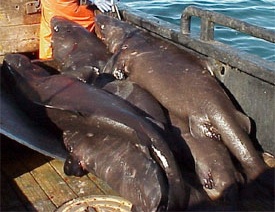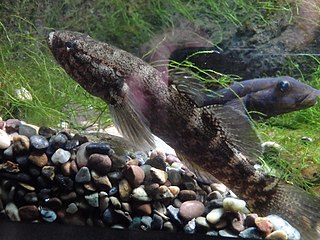
The Pacific sleeper shark is a sleeper shark of the family Somniosidae, found in the North Pacific on continental shelves and slopes in Arctic and temperate waters between latitudes 70°N and 22°N and in at least two places in the western tropical Pacific near Palau and the Solomon Islands, from the surface to 2,000 metres (6,600 ft) deep. The first evidence of the sharks in the western tropical Pacific emerged from a National Geographic video taken near the Solomon Islands in 2015. Its length is up to 4.4 m (14 ft), although it could possibly reach lengths in excess of 7 m (23 ft).

The Greenland shark, also known as the gurry shark, grey shark, or by the Kalaallisut name eqalussuaq, is a large shark of the family Somniosidae, closely related to the Pacific and southern sleeper sharks. The Greenland shark is a potentially important yet poorly studied cold-water species inhabiting the North Atlantic and Arctic Oceans.

The plunket shark or Plunket's shark is a sleeper shark of the family Somniosidae, found around south eastern Australia, and New Zealand, at depths of between 220 and 1,550 m over continental shelves. It reaches a length of 130 cm.

The knifetooth dogfish, is a harmless sleeper shark of the family Somniosidae, found in the eastern Atlantic, from Scotland to Spain, Portugal, and Senegal, and the southwest Pacific from New Zealand, between latitudes 58°N and 15°N, at depths of between 200 and 1,600 m. Its length is up to 1.1 metres (3.6 ft).

The southern sleeper shark or Whitley's sleeper shark is a deepwater benthopelagic sleeper shark of the family Somniosidae found in the southern Atlantic, Indian, Pacific, and Antarctic oceans.

Eleotris sandwicensis, the Sandwich Island sleeper, Hawaiian sleeper or oopu, is a species of fish in the family Eleotridae endemic to the Hawaiian Islands, where it can be found in marine, fresh, and brackish waters around the coast. Due to this capability of migrating between different marine environments, they are amphidromous. This fish can reach a length of 33 cm (13 in). It is locally important to commercial fisheries and is also used as bait by fishermen after larger fishes. In the Hawaiian language, the fish is also known as oʻopu, ʻoau, ʻowau, and hiʻu kole.

Cavefish or cave fish is a generic term for fresh and brackish water fish adapted to life in caves and other underground habitats. Related terms are subterranean fish, troglomorphic fish, troglobitic fish, stygobitic fish, phreatic fish and hypogean fish.

The finless sleeper ray is a species of electric ray in the family Narkidae, and the sole member of its genus. It is found over the continental shelf of Southeast Asia from the eastern Andaman Sea to Vietnam and Borneo. Typically growing no more than 15 cm (5.9 in) long, it may be the smallest cartilaginous fish. The finless sleeper ray is the only electric ray that lacks dorsal fins. It has an oval pectoral fin disc that varies from longer than wide to wider than long, depending on age, and a short, robust tail that terminates in a short, deep caudal fin. The trailing margins of its pelvic fins are sexually dimorphic, being more concave in males.

RNA-Seq is a sequencing technique that uses next-generation sequencing (NGS) to reveal the presence and quantity of RNA in a biological sample, representing an aggregated snapshot of the cells' dynamic pool of RNAs, also known as transcriptome.

The Japanese sleeper ray is a species of electric ray in the family Narkidae. It is common in the inshore and offshore waters of the northwestern Pacific Ocean from southern Japan to southern China. Growing up to 40 cm (16 in) long, the Japanese sleeper ray has a nearly circular pectoral fin disc colored reddish to chocolate brown above, sometimes with darker or lighter spots, and lighter brown below. The spiracles behind its small eyes have raised, smooth rims. Its short and muscular tail bears a single dorsal fin positioned aft of the rounded pelvic fins, and terminates in a large caudal fin.

Acheilognathus macropterus is a species of cyprinid fish native to China and northern Vietnam. It grows to a length of 27.5 centimetres (10.8 in) SL.

The dark sleeper, Odontobutis obscura, is a species of freshwater sleeper native to China, Japan, and Korea. This species can reach up to 25 cm (9.8 in) in length. It is a commercially important species. This species is also variously called Toadonn, Toadfish, and Toadle.

Odontobutis is a genus of freshwater sleepers native to East Asia and Vietnam.
Odontobutis haifengensis is a species of freshwater sleeper endemic to China where it is only found in fresh and brackish waters of Guangdong Province. This species can reach 10.7 cm (4.2 in) in standard length.
Odontobutis hikimius is a species of freshwater sleeper endemic to Japan. This species can reach a length of 15.6 cm (6.1 in) in standard length.
Odontobutis yaluensis is a species of freshwater sleeper endemic to China.
Single-cell sequencing examines the sequence information from individual cells with optimized next-generation sequencing technologies, providing a higher resolution of cellular differences and a better understanding of the function of an individual cell in the context of its microenvironment. For example, in cancer, sequencing the DNA of individual cells can give information about mutations carried by small populations of cells. In development, sequencing the RNAs expressed by individual cells can give insight into the existence and behavior of different cell types. In microbial systems, a population of the same species can appear genetically clonal. Still, single-cell sequencing of RNA or epigenetic modifications can reveal cell-to-cell variability that may help populations rapidly adapt to survive in changing environments.
Terateleotris aspro is a species of freshwater sleeper endemic to the Mekong basin in Laos. It inhabits shallow backwaters with sand-gravel substrates. This species grows to a length of 10 centimetres (3.9 in) SL. This species is the only known member of its genus.

In epitranscriptomic sequencing, most methods focus on either (1) enrichment and purification of the modified RNA molecules before running on the RNA sequencer, or (2) improving or modifying bioinformatics analysis pipelines to call the modification peaks. Most methods have been adapted and optimized for mRNA molecules, except for modified bisulfite sequencing for profiling 5-methylcytidine which was optimized for tRNAs and rRNAs.
Transcriptomics technologies are the techniques used to study an organism's transcriptome, the sum of all of its RNA transcripts. The information content of an organism is recorded in the DNA of its genome and expressed through transcription. Here, mRNA serves as a transient intermediary molecule in the information network, whilst non-coding RNAs perform additional diverse functions. A transcriptome captures a snapshot in time of the total transcripts present in a cell. Transcriptomics technologies provide a broad account of which cellular processes are active and which are dormant. A major challenge in molecular biology is to understand how a single genome gives rise to a variety of cells. Another is how gene expression is regulated.














